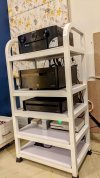That makes sense in a way. It is a very interesting postulation, in fact.
A. Is it just the dynamic range that sucks power? Or to put it another way: does the dynamic range of movies require huge power?
Like, as I have said before, my music preference is hip-hop, r&b and jazz, all of which have a kind of dynamism about them. Am sure, all kinds of pop and rock also have them, but true, may not be to the level of these genres... where there could be passages of melody and then passages of sheer big drops.
B. But to be sure, will other kind of smooth, flowing music with not much dynamism not require as much power?
Would love for you and other FMs to weigh in. (Disclosure: Am learning really from the bottom-up in this hobby, so if the question is stupid, kindly ignore it)
I have read so many measures, both hobbyist and scientific, which have called out Klipsch.
The one I could find from the top of my head, am attaching here:
View attachment 63255
The Klipsch RP-8000F, a dual 8" woofer tower speaker system that promises a wide dynamic range for lots of punch and impact, but will that come at the cost? Read our review to find out...

www.audioholics.com
Having said that, I can tell you (to my ear; YMMV) the Klipsches were the most easiest to power among ALL the speakers I have auditioned so far.
I listened to them powered by a Denon 1400, and those bad boys (RP-5000F) were relentless, be it for music or movies. They weren't even as bright as people with the earlier R series had mentioned.
That's interesting, this correlation between sensitivity and size. Will read up on this. (So much to research in this hobby!)
This, as of right now, is way beyond my knowledge, as with most things. And, as always, will read up to try and get up to speed.
This, especially, I did not understand:
"Most people think in home audio that a 7-8" mid-woof is large but it isn't, whether a ported or sealed enclosure these will have limited sensitivity."



